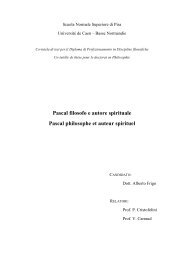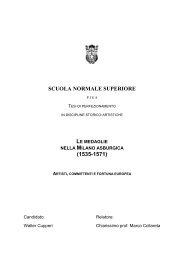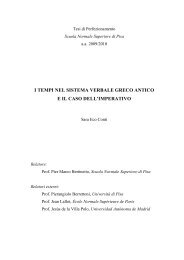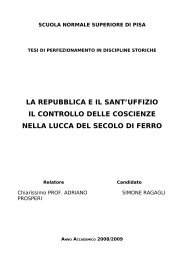CATULLUS 68 - Scuola Normale Superiore
CATULLUS 68 - Scuola Normale Superiore
CATULLUS 68 - Scuola Normale Superiore
You also want an ePaper? Increase the reach of your titles
YUMPU automatically turns print PDFs into web optimized ePapers that Google loves.
caeli … ianua ianua autem est primus domus introitus, dicta quia Iano consecratum est omne principium<br />
(Serv. in Verg. Aen. 1.449): ianua was used for the door of a building, similarly to fores, while porta was<br />
reserved for the gates of a city or a fort. The Romans imagined the abode of the gods in the sky (and also the<br />
nether world) not as a walled city but as a house: compare Enn. Ann. 586 Sk. diuom domus altisonum cael,<br />
Lucr. 6.358 caeli domus and Verg. Aen. 10.101 deum domus alta, and see TLL 5.1.1978.44-70 and 1978.79-<br />
1979.14.<br />
116 Hebe nec Hebe was equated with the native Roman goddess Iuuentas (see Hor. Od. 1.30.7 with<br />
Nisbet & Hubbard 1970 ad loc.) but tends to retain her Greek name in mythological poetry: thus also at Ov.<br />
Met. 9.400, Stat. Silv. 3.1.27, Val. Fl. 8.231 and [Sen.] Oct. 210 deus Alcides possidet Heben.<br />
In O the letters Heb are followed by a high dot with an inverted c-shape around it and below this a small sign<br />
resembling a 2. Thomson in app. tentatively interprets this as Hebe et.<br />
117 Catullus boldly compares the depth (i.e. the profundity, the commitment and force) of Laodamia’s love<br />
with the depth (i.e. the physical depth) of the cave excavated by Hercules.<br />
Fröhlich (1849: 265) would rewrite the verse as sed tuus ardor amore adeo fuit acrior illo, but Hercules is<br />
not in love with Hebe, and lines 117f. show that Laodamia’s love has to be compared not with his feelings<br />
but with the barathrum.<br />
tuus altus amor ‘Your profound love’ for Protesilaus. There is no exact parallel for altus amor, but the<br />
epithet is used regularly of feelings and sensations: compare Verg. Aen. 1.209 premit altum corde dolorem<br />
together with CE 1183.7 = CIL 9.3279 (from Corfinium) hic finem dolor altus habet, Tac. Hist. 4.82.1 altior<br />
inde Vespasiano cupido adeundi sacram sedem, OLD s.v., 15a and TLL 1.1781.5-27.<br />
On tuus amor ‘your love (for somebody else)’ see on line 24.<br />
118 The principal MSS write the first pentameter of this verse as qui tuum domitum, which is patently<br />
corrupt. How should it be corrected? Recent editors have written either qui tamen indomitam ferre iugum<br />
docuit with Heyse and Statius (thus Mynors, Quinn, Goold, Thomson, Perez Vega and Ramírez de Verger)<br />
or qui tunc indomitam ferre iugum docuit with Corradinus de Allio and Statius (Kroll), taking the relative<br />
clause to describe Laodameia’s amor, which is mentioned in the previous line (sed tuus altus amor barathro<br />
fuit altior illo). However, there are a number of difficulties with these reconstructions. Trappes-Lomax<br />
(2007: 241) rightly points out that qui tamen indomitam ferre iugum docuit cannot mean ‘unbroken though<br />
she was, it taught her to carry the yoke’, as “where tamen follows a relative pronoun it implies an opposition<br />
between the content of the main clause and the content of the relative clause so that knowing the former one<br />
would not expect the latter; cf. OLD s.v. tamen 6”. He advocates the solution advocated by Kroll – but tunc<br />
would be a bland and quite meaningless stop-gap (for the dangerous temptation to reconstruct words of this<br />
type see line 91n.). But there is another argument against both these reconstructions. They let the relative<br />
clause in the pentameter qualify a word in the middle of the hexameter: sed tuus altus amor barathro fuit<br />
218






